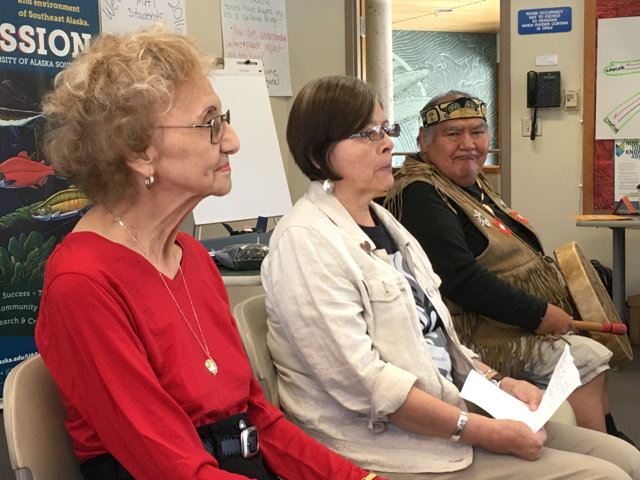I invited three Elders to talk with you about education – to share advice for new teachers.
Selina Everson (left) fights for Tlingit language and culture preservation. She grew up speaking Tlingit. It was her first language. At school, she was told to speak only English. Ms. Everson broke that rule and courageously spoke Tlingit anyway. Ms. Everson remains a champion for her culture as a Tlingit language teacher. She’s known as “Grandma Selina” by hundreds of children at the school where she teaches. More
Linda Belarde (center) is a life-long educator. Most recently, she worked for Sealaska Heritage Institute as a Tlingit Curriculum Specialist. She is passionate about preserving the Tlingít language and culture having created many language resources and developing culutrally relevant curriculum for use in public schools. More
David Katzeek (Kingeistí) is most known for his years of service and leadership in the Tlingit community and as a clan leader for the Eagle Moiety, Shangukeidí Clan of Klukwan. Katzeek is a Chilkat Eagle Tlingit of the Shangukeidí Clan from the Thunderbird House, the House Lowered by the Sun, and the Tree Bark House in Chilkat Kwáan Klukwan, Alaska, after his mother Anna Klanott Katzeek (1925-2011).
Mr. Katzeek has worked in business and finance prior to becoming the first president of Sealaska Heritige Foundation (now Insititute) from 1982-1992. Since that time Katzeek has been a financial and cultural consultant. He has been a consultant to numerous Tlingit organizations, such as the Sealaska Heritage Institute and Goldbelt Heritage Foundation. He has also served on the Sealaska Heritage Institute’s Council of Traditional Scholars for nearly two decades. He has devoted much of his time in the past decade to education, especially within the K-12 education system in the Juneau School District. More
Task: Write a blog post that responds explains:
- What advice did you hear that resonated with you?
- What implications might this have for you as a teacher?

The advice that resonated with me was how important is was for Mrs. Everson (and the others) to keep their language (and how painful it was to lose it for a time).
I would like to incorporate aspects of whichever Native language I am immersed into my teaching. However, I’m sure (because of practical considerations, time, focus, etc) the amount of any non English language that my class will be exposed to will have to be relegated to key terms that have particular resonance or meaning in the local Native tongue. Additionally, as a Language Arts teacher I definitely plan on exploring the Oral (and written) stories of Native cultures and authors.
David speaks with such passion, conviction and love. He made three very powerful statements on Monday- “You have it in you,” “You are a precious child,” and “you are a human being.” Peter talks about essential questions, well I think that these are the essential statements; things that students need to hear over and over until they truly believe it- not just about themselves but about each other-and begin to act accordingly. What a beautiful, empowering way to create a feeling of community in the classroom.
When David spoke today about his achievements I was taken by his humility and his desire to serve his people. I was reminded of a passage in the Oleksa book where he speaks about the Yup’ik story, Eye of the Needle. He says, “Children become members of society by realizing that the purpose of their existence goes beyond satisfaction of their own selfish desires, whims, or passions. Each must become the servant of something other than, and more important than, his or herself.” (p53)
What a great perspective. I feel like as a teacher I need to be humble to be able to recognize, acknowledge and build upon the cultural collateral each student brings to the classroom. I will definitely be using these traditional native stories this fall as we read Touching Spirit Bear and The Outsiders.